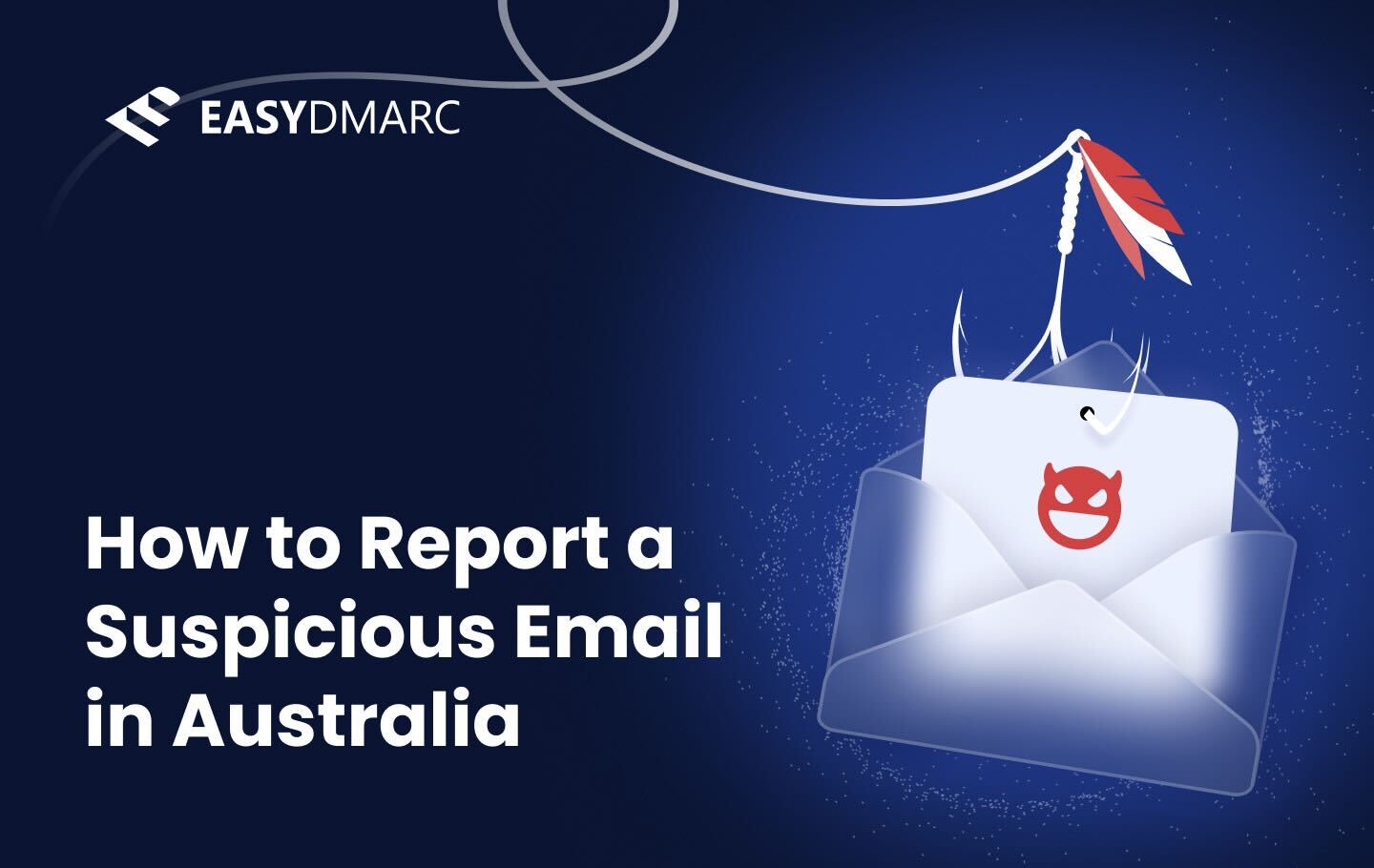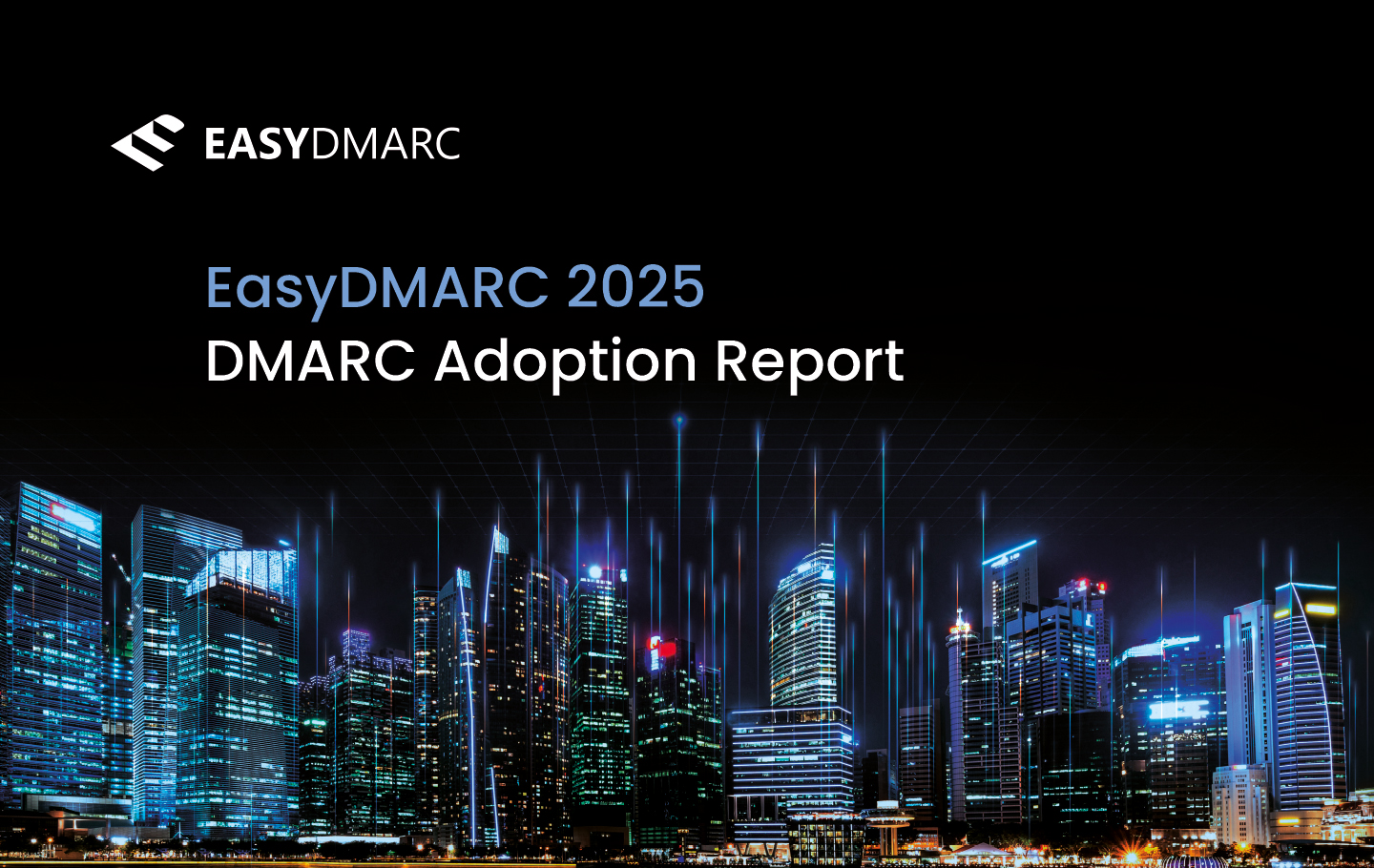Email scams are now one of the most common online threats in Australia. Every day, people receive messages pretending to be from banks, delivery services, or even government agencies, all trying to steal personal details or money. Knowing how to report a suspicious email in Australia helps protect you and others from falling for the same tricks while helping authorities take down cybercriminals.
When scam emails go unreported, attackers can keep using the same tactics to reach more people. Reporting these messages allows the right organizations to investigate, block similar attempts, and warn the public about new scams. It’s a small action that makes a big difference in keeping Australia’s digital space safer for everyone.
Of course, prevention is just as important as reporting. Tools like DMARC (Domain-based Message Authentication, Reporting, and Conformance) can stop fake emails before they ever reach your inbox. With solutions like EasyDMARC, businesses can verify legitimate senders and prevent domain misuse, reducing the risk of phishing and impersonation altogether.
Why Reporting Suspicious Emails Matters
Besides keeping your own inbox safe, reporting suspicious emails plays a key role in protecting the entire online community. In Australia, phishing and scam emails continue to cause serious problems for both individuals and businesses. Many of these attacks aim to steal personal data, access bank accounts, or install harmful software on devices. For companies, the damage can be even greater, leading to data breaches, financial loss, and a damaged reputation.
By reporting these emails, you help authorities and service providers track new scam patterns and shut them down faster. Each report adds valuable information that helps improve national cybersecurity defenses and strengthen spam filters for everyone. The more people report, the harder it becomes for attackers to operate successfully.
Before you report a message, it’s a good idea to double-check if it’s truly dangerous. Instead of clicking any links, you can scan them safely using EasyDMARC’s Phishing Link Checker. It helps you verify suspicious URLs without opening them, so you can report confidently and stay safe in the process.
Key Warning Signs of Phishing and Scam Emails
Scam and phishing emails often look convincing, but there are always small details that give them away. If you know what to look for, you can easily spot and report them before any harm is done. Here are the most common red flags to keep in mind:
Unusual or Misspelled Sender Address: Always start by checking who the email is from. Scammers often use fake addresses that look similar to official ones; for example, “[email protected]” instead of “[email protected].” If the sender’s domain doesn’t match the organization it claims to be from, that’s an immediate warning sign.
Urgent or Fear-Based Tone: Phishing emails often try to scare or rush you into acting quickly. Phrases like “Your account will be suspended” or “You must verify your identity now” are common tricks. Real companies usually don’t pressure customers into clicking links or sharing personal information right away.
Suspicious Links and Attachments: Be cautious with links or files in emails, especially if you weren’t expecting them. Hover your mouse over a link (without clicking) to see where it leads. If the URL looks strange or doesn’t match the sender’s address, don’t open it. Attachments from unknown senders can also contain harmful software.
Grammar or Formatting Errors: While not always obvious, many scam emails contain spelling mistakes, poor punctuation, or awkward wording. Legitimate organizations usually have professional communication standards, so sloppy writing can be a strong indicator that something’s off.
Requests for Personal Information or Payments: No genuine business or government agency will ask you to share passwords, bank details, or verification codes through email. If a message asks for sensitive information, it’s almost always a scam.
Offers That Sound Too Good to Be True: Emails claiming you’ve won a prize, received an unexpected refund, or been selected for a reward are usually scams. If it feels unrealistic, it probably is.
Simply put, don’t click any links or open attachments until you’re sure the message is legitimate. Start by verifying the sender by contacting them through official channels, like the phone number or website listed on the organization’s official website, but do not use the details provided in the email.
Tools That Help Detect Email Spoofing
Most email platforms like Gmail, Outlook, and Yahoo use built-in filters that automatically detect and move suspicious messages to the spam folder. Still, these systems aren’t perfect, and some phishing attempts can slip through. To stay safer, you can use dedicated tools that scan email headers, links, and domain information to confirm if the message actually comes from who it claims to.
Link-checking tools are also a way to see if a message is safe before clicking. But for businesses, email scams can cause far bigger problems; one mistake can expose sensitive data, harm customer trust, or even disrupt operations. That’s why companies need stronger protection systems like EasyDMARC that work automatically in the background and use authentication standards such as SPF, DKIM, and DMARC. These checks make sure that only approved senders can use the company’s name in emails, reducing the risk of phishing and domain impersonation.
What is Email Spoofing?
Email spoofing is when a bad actor forges parts of an email so it looks like it came from a trusted source, like a person you know, a company you use, or a domain you frequent. Attackers do this to trick you into opening attachments, clicking links, or replying with personal details and credentials. Typically, opening attachments or clicking links will install malware on your device to collect information or otherwise disrupt your normal activities, while responding with credentials is usually part of a larger overall scam operation.
The Risks of Misconfiguring DMARC
If an organization does not configure DMARC properly, there are two main risks: Spoofing Risk (outgoing risk), and Spoofed-Email Reception (incoming risk).
Spoofing Risk
Cybercriminals can send fake emails pretending to be from your domain. Your customers, suppliers, or partners may receive these fraudulent emails and think they’re really from you.
This damages trust, brand reputation, and can lead to phishing or financial fraud against your clients.
Spoofed-Email Reception
Without DMARC (and related checks like SPF and DKIM), your company’s email servers are less able to detect when others are spoofing external domains. Your employees are more likely to receive phishing or spoofed emails that slip past filters because your email system isn’t enforcing authentication rules. This can lead to stolen credentials, malware infections, or data loss.
How do I Report a Suspicious Email in Australia
Reporting a suspicious email in Australia usually means either reaching out to government agencies or your email provider. Here’s how to do it:
Reporting to the Australian Cyber Security Centre (ACSC)
The Australian Cyber Security Centre (ACSC) collects reports about phishing and scam emails to help identify and shut down large-scale attacks. If you’ve received a suspicious email, forward it directly to [email protected] without changing the subject line.
You can also submit a report through the ReportCyber portal, which lets you describe what happened and upload any screenshots or details. These reports help authorities track ongoing scams and protect other users from falling for the same messages.
Reporting to the Australian Competition & Consumer Commission (ACCC) Scamwatch
The ACCC’s Scamwatch service collects reports of scams, including phishing and email spoofing, to help warn the public and protect others from being targeted. If you’ve received a suspicious email that looks like part of a broader scam, such as fake invoices, investment offers, or impersonation attempts, you can report it directly through the Scamwatch website.
Your report helps the ACCC identify scam trends and publish national alerts about ongoing threats. While Scamwatch does not investigate individual cases, the information you share contributes to a national effort to track and disrupt scammers operating in Australia.
Reporting to Your Email Provider
Most email services have built-in tools that let you report phishing or spam quickly. This not only removes the message from your inbox but also improves filters for everyone using the same platform.
- Gmail: Open the email, click the three dots in the top-right corner, and select “Report phishing.”
- Outlook: Select the message, go to the toolbar, and choose “Report”, then “Phishing.”
- Yahoo Mail: Click the three dots above the email and select “Report a phishing scam.”
- Apple Mail: Forward the suspicious email to [email protected] or move it to the Junk folder.
Reporting Corporate or Work Email Threats
If the suspicious email was sent to your work account, it’s best not to forward it outside the organization. Instead, notify your IT or security team immediately. They can check the email safely, isolate the threat, and ensure no other employees were targeted.
Many companies also have dedicated channels or ticketing systems for security incidents. Reporting through these systems helps IT teams log the threat properly and take quick action to prevent potential breaches.
How Do I Report Spam Emails in Australia
Not every unwanted email is a phishing scam. Sometimes, it’s just spam. While these messages might seem harmless, constant spam can clutter your inbox, waste time, and occasionally hide risky links. Knowing how to report spam emails in Australia helps reduce the volume of junk mail and supports authorities in stopping mass senders who ignore anti-spam laws.
Spam vs Phishing: Know the Difference
Phishing emails are designed to steal personal information such as passwords, credit card numbers, or banking details. They often look like official messages from trusted organizations but contain fake links or attachments. Spam emails, on the other hand, are mass-sent promotional or irrelevant messages that usually try to sell products or services. While most spam is harmless, some may still contain unsafe links that lead to fake websites or malware. In order to decide how and where to report them, you need to recognize these differences.
Reporting Spam to the ACMA or Your Email Provider
Many Australians also ask, how do I report spam emails in Australia? While the process is similar to reporting phishing, it involves slightly different channels and authorities. If spam keeps appearing in your inbox, you can report it to the Australian Communications and Media Authority (ACMA). The ACMA enforces the Spam Act 2003, which protects Australians from unwanted commercial electronic messages. By reporting spam, you help the ACMA identify repeat offenders and reduce the overall number of junk emails sent nationwide. Reports can be submitted through the ACMA’s official website, and serious or repeated violations may lead to investigations or fines for the senders.
You can also continue to use your email provider’s built-in spam reporting tools, which we mentioned earlier. Each time you mark a message as spam, your email service learns to recognize and filter similar emails automatically, keeping your inbox cleaner over time.
How to Protect Yourself After Reporting
Reporting a suspicious or spam email is a great first step, but your protection shouldn’t stop there. It’s important to take a few simple actions afterward to make sure your personal information and accounts stay secure.
Change Your Passwords: Choose strong, unique passwords for each account, using a mix of letters, numbers, and symbols. Avoid reusing the same password across multiple sites. A password manager can help you create and safely store complex passwords without having to remember them all.
Turn On Multi-Factor Authentication (MFA): Adding multi-factor authentication gives your accounts an extra layer of security. Even if someone gains access to your password, they won’t be able to log in without the additional verification code from your phone or another device. Most major platforms, including Google, Apple, and Microsoft, offer this feature, and it takes only a few minutes to set up.
Check Your Email and Security Filters: After reporting suspicious emails, review your email settings to make sure spam filters are active and updated. Well-tuned filters can block similar threats before they ever reach your inbox. Take a quick look through your junk folder, too, to make sure legitimate messages aren’t being filtered out by mistake.
Review Your Email Authentication Setup: If you manage or represent a business, it’s important to check that your domain is protected against impersonation. This means verifying your SPF, DKIM, and DMARC records are properly configured to stop unauthorized senders from using your domain in phishing attacks.
Strengthen Email Security with DMARC: For long-term protection, businesses can improve their email security with DMARC, which works together with SPF and DKIM to verify that messages sent from your domain are real and not from impersonators trying to misuse your name.
With EasyDMARC, setting up, managing, and generating DMARC records becomes much easier. The platform helps you monitor who’s sending emails from your domain and quickly spot any unauthorized activity. By blocking fake messages before they reach inboxes, DMARC helps protect your brand, your employees, and your customers from phishing and fraud attempts.
Keep Your Inbox and Identity Secure
Staying safe from phishing and scam emails is an ongoing effort. Awareness, regular habits, and smart tools all play a part in keeping your inbox and identity protected. Start with awareness; always look closely at who an email is from, check links before clicking, and avoid sharing personal details through email. If something doesn’t feel right, report it immediately. Each report helps authorities and email providers stop scams faster and make inboxes safer for everyone.
For workplaces, regular cybersecurity training is one of the most effective ways to prevent attacks. Teaching employees how to recognize phishing attempts, manage passwords, and use multi-factor authentication reduces the risk of costly data breaches. Businesses can also strengthen their email protection by setting up authentication systems like DMARC, SPF, and DKIM, easily managed through platforms such as EasyDMARC, to verify legitimate senders and block impersonation attempts before they reach inboxes.
Frequently Asked Questions
Once you report a suspicious email, organizations like the Australian Cyber Security Centre (ACSC) review your report and use it to track phishing campaigns or block dangerous domains. Email providers also analyze reported messages to improve their spam filters and prevent similar scams from reaching other users.
After you’ve reported the email to the ACSC or your email provider, it’s best to delete it right away. Don’t reply, click links, or download any attachments. If you accidentally interacted with it, change your passwords and monitor your accounts for unusual activity.
Forward the message to 7226 (SPAM), which sends it directly to your mobile provider for analysis. You can also take a screenshot and report it through Scamwatch or the ReportCyber portal. Never tap on links in suspicious texts, even if they look urgent or come from familiar names.
Spam emails are mostly unwanted advertisements or mass promotions. They’re annoying but usually harmless. Phishing emails, on the other hand, are created to steal personal information, install malware, or trick you into revealing sensitive data. While both should be reported, phishing poses a higher security risk.
Businesses can reduce phishing risks by training employees to recognize scam attempts, using strong spam filters, and enabling email authentication protocols like SPF, DKIM, and DMARC. Tools such as EasyDMARC help manage these records effectively and make sure that only verified senders can send emails using the company’s domain.


